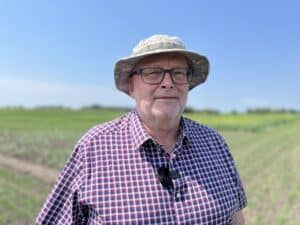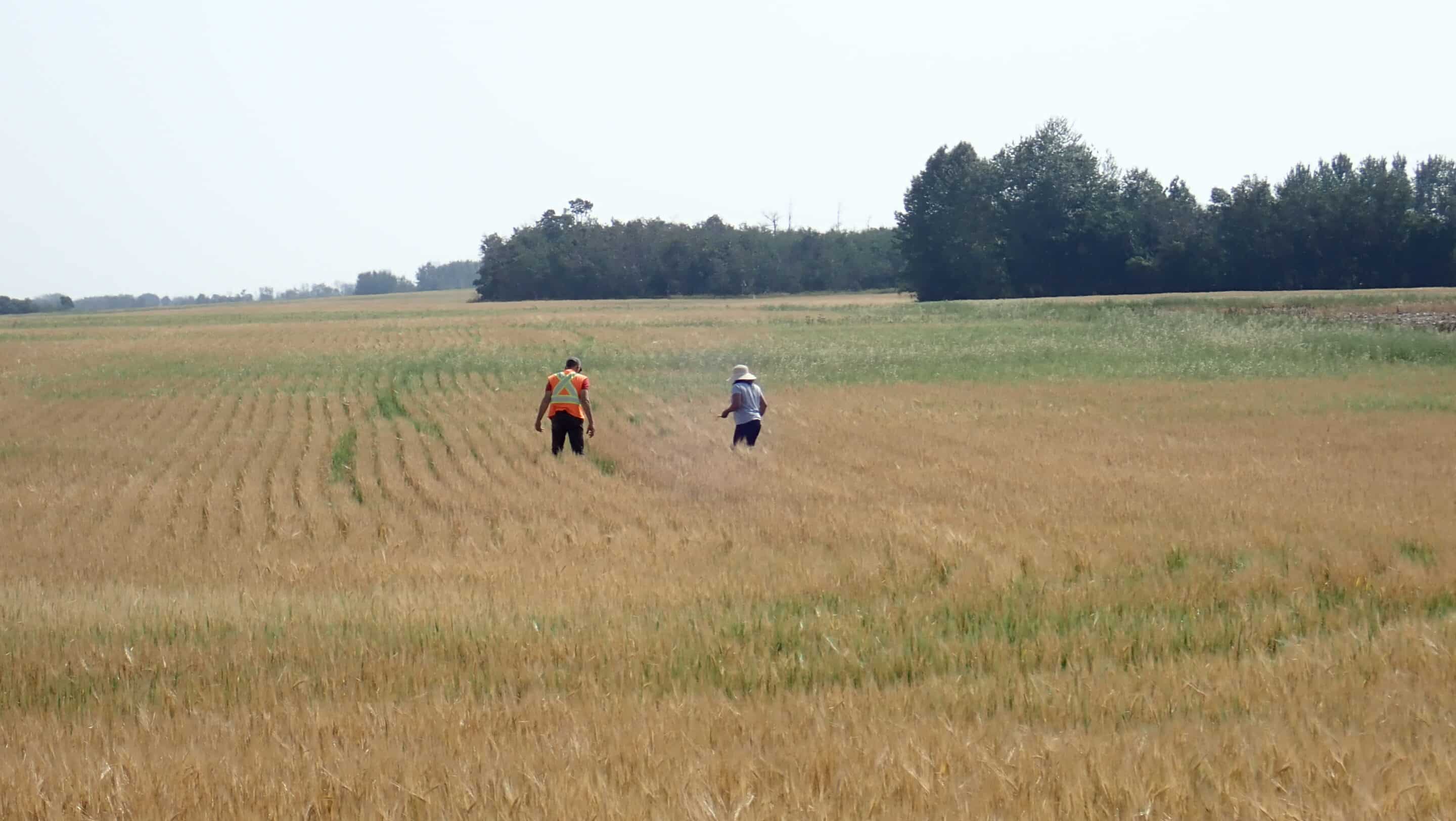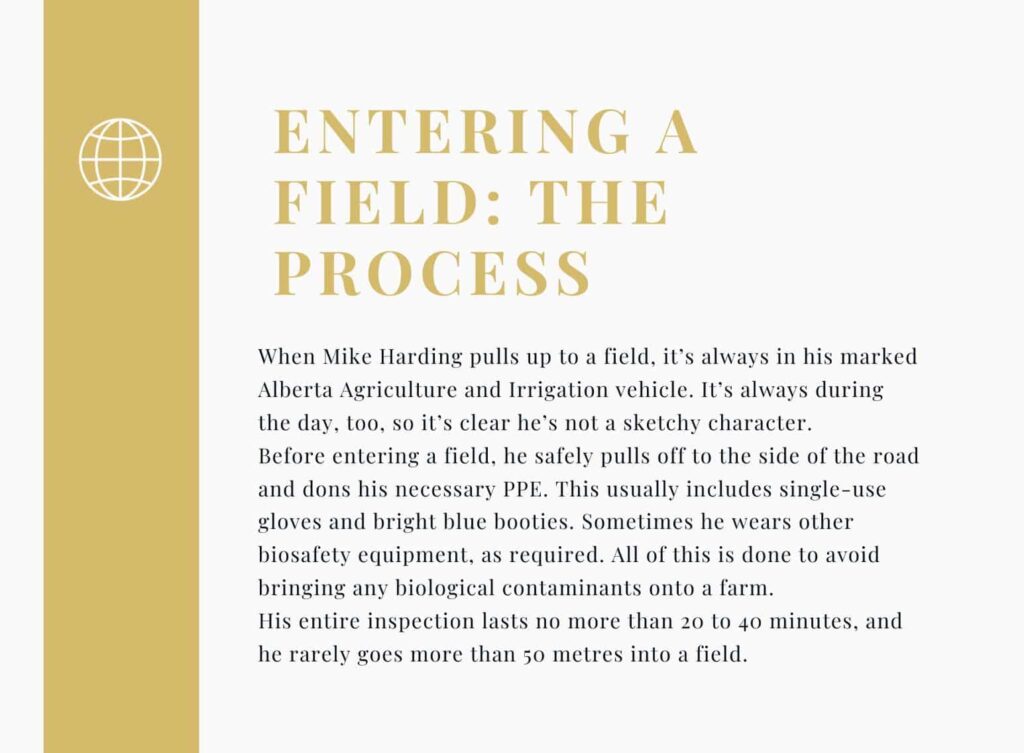Scientists have long relied on entering fields at random to conduct important research work but that is now at risk.
Research scientists who study plant weeds, pests and diseases routinely enter random farm fields to create beneficial reports. Without being able to gain access to regularly monitoring plants, this critical extension aspect of their job would be extremely difficult to complete. The practice, though, is well understood by Prairie farmers, who know the plant material scientists extract is carefully removed, analyzed and later used to ultimately benefit additional researchers, breeders and farmers with informed management information.
That said, not all access by government staff is viewed so positively by farmers. The work of government came into a contentious limelight in August, 2022 when federal employees were collecting water samples from dugouts at Pense, Sask. The story made headlines, saw mudslinging happen between Regina and Ottawa and even sparked a knee-jerk Order in Council by the Saskatchewan government to amend its trespassing laws immediately after the news broke.
Across the Prairies, rules differ for provincial employees and what level of permission is required to enter a field. Federally, all employees must have explicit permission from a landowner prior to entering a field for any reason. Agriculture and Agri-Food Canada (AAFC) would not answer specific questions about field access, and only supplied a pre-written statement which noted, in part, that: “All AAFC research teams are required to seek written permission before accessing private lands. To facilitate the process, a land access permission system is in place for this important AAFC on-farm research to continue.”
Researchers are concerned less access and ability to monitor could greatly impact the work they do to bring farmers quality information in a timely manner.
Mike Harding works for the provincial government at Brooks, Alta., where his scientific work focuses on plant pathology. His work requires access to farmers’ fields and it’s not a responsibility he takes lightly.
“If we want to do our best as a province to avoid or manage or deal with these issues, we have to measure them,” he says. “If we don’t have a measurement of where we’re at with pests, weeds and diseases, we won’t know if they’re getting worse or getting better.”
Each year, the crop survey window lasts about one month, beginning in July with peas, wheat and barley, and ending in August-September with wheat heads and canola. Surveys in large acreage field crops such as wheat and canola will typically involve anywhere between 300 to 500 fields each year. Other crops like pea and barley will target around 100 fields. Not every crop is evaluated every year, so there may be no visits to fields of corn, oat or potato in a given year.
Every field he enters, Harding follows the exact same strict protocols. Once inside the field, he sometimes clips the leaves, heads, or seed pods if they appear diseased. In other cases, such as a root disease, he will remove a few plants in their entirety, place them into individual bags and leave.
Sometimes his junior employees simply bag samples and bring them back to the lab for analysis, or a representative of the local municipality, such as an agricultural fieldman from the county or municipal district. In most cases, he estimates the relatively small amount of sample collection results in between five and 10 cents of damage.
“We’re not removing economic levels of crop from the field,” he says. “You’d have to take a lot more plants than we do to cause any real measurable damage.”
For other inspectors or researchers, such as entomologists, they set up traps and check them on a regular basis. Other times they walk into a field with a sweep net to catch certain insects. Sampling can be both destructive or non-destructive, depending on the situation or focus of a survey. Weed scientists would almost invariably remove entire plants to study them in the lab, although at times only sections of a weed may be removed for classification and examination.
So, why do these plant health specialists make unannounced visits to agricultural fields?
Harding says it’s because good data and information must come from random and representative sampling.
“Just like a good soil sample must be random and representative, pest surveillance and monitoring must make stops randomly in representative numbers of fields to provide quality information on pest situations,” he explains. “We always contact landowners when it’s possible, but notifications for random visits to 500 fields across the entire province is not feasible.”
In his career, he’s recalls three negative encounters with landowners. Most times he never sees the landowner and, the times he has, the interactions are overwhelmingly positive.
“Most producers understand the importance of what we do, and often have lots of questions about managing specific pest issues on their farm, which we are always happy to discuss and provide information about.”
Random sampling requires field access and is essential for good quality information used to make informed management decisions.
He notes that while provincial disease monitoring may not be critical information for an individual farm, it’s collectively important because it informs forecasts for the coming year, provides early warnings for emerging issues or even as far as helping to resolve a trade or tariff issue.
“If [a buyer from a country] says you have this pest and we’re closing the market to you, we’re not going to receive any more of your commodity, it’s nice to have four years of survey data in your pocket to deal with that rather than say, ‘OK, well, give us four years to start surveying to see if it’s here.’”
Harding says working with federal bodies such as the Canadian Food Inspection Agency (CFIA) and AAFC collaboratively make everyone’s life easier when it comes to resolving these types of issues, and he and his team are always keen to partner up.
“We have a lot of proof and evidence that Alberta’s crops are some of the cleanest, healthiest with the best quality anywhere in the world. That’s one of the things that we look at and it shows some of the value of these programs.”
How Government Researchers Can Enter Your Field Throughout the Prairie Region
| Federal Employees | Provincial Employees | |
| Alberta | Written permission from the landowner | Unlimited access, no prior permission required |
| Saskatchewan | Written permission from the landowner | Text, verbal or written permission is required from the landowner |
| Manitoba | Written permission from the landowner | Text, verbal or written permission is required from the landowner |
For Kelly Turkington, a federal plant pathologist based in Lacombe, Alta., he says the situation is cut-and-dry regarding field access.
“To develop effective strategies to mitigate these diseases, we need to know what is out there for producers,” he says. “Sometimes it’s not considered to be an important activity. It’s not considered to be research, and I find that very disappointing because it’s a foundational activity to all of the other subsequent research done by pathologists, molecular biologists and breeders.”
Plant pathogens can adapt to host resistance genes and potentially develop fungicide resistance, while disease patterns can begin to emerge in relation to emerging weather patterns. Further research and associated technology transfer provides producers with key information to make informed variety selections and fungicide choice and timing decisions.
Funding bodies also use survey information to understand what emerging issues need research support, which is paid for by farmers through producer groups.

Kelly Turkington, a crop pathologist at Agriculture and Agri-food Canada’s Lacombe Research and Development Centre
The work, while straightforward and seemingly elementary, ushers in huge benefits to both farmers and researchers that has massive upside.
“We collect critical samples of diseased plant material, and that material is then used for subsequent research,” says Turkington.
When pathologists obtain contaminated samples, they derive pure plant pathogen isolates. These isolates are then studied using indoor growth facilities and laboratories in relation to virulence and fungicide sensitivity shifts as well as using molecular tools to further characterize pathogen populations.
As better knowledge and understanding of disease and pathogen characteristics develop, breeders and pathologists can then improve the available varieties and overall disease management strategies. Ultimately this results in producers being able to choose the most effective varieties, fungicides and disease control tools.
Field sampling ultimately moves upstream and benefits pathologists, molecular biologists and plant breeders. Pathologists identify disease and pathogen characteristics which leads to better disease management tools. For plant breeders it helps them to understand how they need to select for future resistant breeding lines, while looking to incorporate various other genes to counteract new or emerging biotic and abiotic stressors.
“Without that information, how can you make a suitable and effective plan of attack to deal with disease issues either from a research or on-farm perspective?” says Turkington.
As for Harding, he understands the issue of having a stranger walk into your field. He says it would concern him, too. “The question you have to ask is what are we possibly going to lose by losing rapid access to fields for crop assurance programs or disease, insect or weed surveillance?”
He quickly answers his own question.
“The ability to obtain high quality information on the status of these potential insect, weed and disease issues. We’ll still be able to generate information, but I don’t see how we can generate high quality useful, predictive information when we aren’t random and representative in our surveillance. I think any producer understands this.”
Header photo — Local ag fieldman and Dilini Adihetty, a PhD student at the University of Alberta, examines variation in the spot blotch pathogen of barley in eastern Alberta in 2021. Photo: Kelly Turkington
Related Articles
The First Cut the Deepest for Alberta Winter Wheat Agronomy Research







